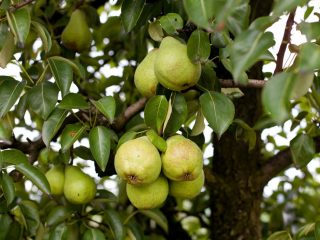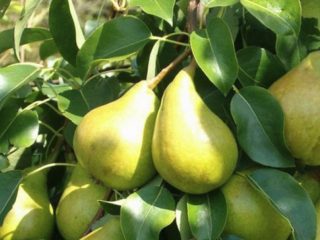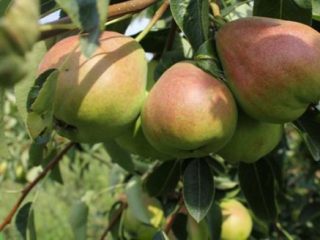Content
If the pear froze in winter, there may be several reasons for this. Often, in combination with frost, the main factors are the lack of mulching and shelter. In all cases, it is necessary to determine the degree of freezing and remove all damaged parts. The basic rules of treatment and care are described in the article.
How to understand that a pear is frozen
Freezing of seedlings and mature trees can be determined by external signs. To do this, you need to carefully examine the plant. The main criteria are:
- The bark of the trunk, skeletal branches or shoots became dark, as in the photo - in this case, the pear was definitely frozen.
- Quite long longitudinal cracks, called frost cracks, are noticeable on the trunk. They can be both superficial and deep. Moreover, this is a characteristic sign that not only the pear, but also other garden trees have frozen.
- If you make a transverse cut, you can see that the core of the shoots and branches loses their light beige, white color and becomes brown, brown.
In the spring (approximately early April) it is even easier to determine the signs of freezing - they appear like this:
- the buds do not open (a significant part died);
- the bark dries out and begins to crack;
- the wood fabric is dark brown in color, it is damp and smells rotten.
Identifying signs of damage is quite simple. But to understand how much damage the tree has suffered, it is necessary to perform a more detailed inspection. Treatment measures also depend on this. For example, even if half the trunk of a two-year-old pear has died, such a seedling can still be saved. The same applies to trees up to five years old. If we are talking about mature crops, it is very difficult to treat them - it is better to take care of planting new seedlings.
If the damage is less significant, the pear can be completely cured. To assess, you need to carefully cut off a small piece of bark and understand how frozen the pear is. To do this, evaluate the color of the cambium (tissue that lies directly under the bark):
- Green - the damage is minimal, such a seedling can be saved, for example, it can be disinfected with brilliant green and covered with a garden varnish.
- Dark brown - severe damage. It appears in cases where the winters were severe and there were temperature changes, especially with short-term thaws. The pear is so frozen that it is very difficult to help it. If the roots are preserved, the tree can also survive. After the soil thaws, you need to dig it up and make cuts on the surface of the roots - if they are not dark, treatment is possible.
- Black is a sure sign that the pear is very frozen. In fact, these are necrotic (dead) tissues; they cannot be restored. There is a high probability that the tree will die - it is better to take care of planting other seedlings.
Why does the pear freeze?
If the pear is frozen, this may be due to an objective reason. Even in the middle zone, especially in the Urals, in Siberia in winter the temperature can drop to -25 degrees and below.The situation is worsened by changes and short-term thaws to above-zero temperatures. In this case, the bark becomes covered with ice, which has a detrimental effect on the tissue. Another provoking factor is a strong cold wind, which literally dries out the plants.

The pear freezes in harsh winters with sudden temperature changes
If the tree is frozen, this may be due to reasons that the gardener can well influence:
- Wrong variety - sometimes gardeners begin to experiment, choosing what exactly to plant on their plot. This is quite normal, but the crop must be chosen in accordance with the climatic characteristics of the region. You can find out more information in the description of the variety, the register of breeding achievements of the Russian Federation, from experienced gardeners, as well as in nurseries.
- Lack or improper preparation for winter - every autumn it is necessary to at least thoroughly mulch the tree trunk circle. And young seedlings are covered with agrofibre and other materials. It is also necessary to use other agrotechnical techniques - moisture-recharging irrigation, pruning, fertilization with ash or potassium phosphate compounds to strengthen the roots.
- Wrong landing site. If the pear is frozen, this may be due to the fact that it is not protected from the winds, especially from the north side of the garden. In addition, you should not choose lowlands where water constantly accumulates. Closely approaching groundwater (at a height of less than 2 m from the soil surface) is also dangerous.
What to do if the pear is frozen
First of all, it is necessary to prune the frozen pear. It is not necessary to start the procedure immediately in March - this can be done in the second half of April or even in early May.The fact is that it is at this time that it is possible to reliably determine where exactly the pear was damaged (the main trunk, young shoots, skeletal branches or other places).
All frozen branches are cut off, avoiding large wounds if possible. Otherwise, black cancer may develop or an infection may penetrate through them, and the overgrowth itself will proceed slowly. If the pear is frozen, then after pruning all places should be treated with garden varnish. The trees are given settled water without fertilizers weekly.
If a large area is frozen and frost holes appear, then they must first be cleaned down to healthy parts. To do this, take a sharp garden knife and carefully scrape off the frozen bark until the tissue is a healthy color. Then they are treated with garden pitch or a 1:1 mixture of mullein and clay (plasticine consistency). The entire frozen surface is covered with burlap or plastic wrap.
If the surface or deep layers of the bark are frozen, then it is also necessary to clean the tree trunk circle, dig it up to 7-10 cm and mulch it. To do this, use humus, peat, sawdust, straw, hay or other natural materials. If the pear is frozen, you can help it with regular weeding and loosening the soil.

First of all, you need to completely cut off or clean the affected parts
What to do if a pear seedling freezes
If a young pear, a seedling under three years old, has frozen, it is much easier to save it. Even if it has become very black, it is possible to restore the plant. In this case, all affected branches must be cut down to healthy parts, then mulched with humus and watered regularly.
Other agricultural techniques are similar - the cuts are treated with garden pitch or a mixture of clay and mullein in a 1:1 ratio. I do all the work with a sharp garden knife - with its help, the bark is cleared to a healthy area. But if it freezes too much, it’s easier to cut off the branch.
What to do if shoots appear from the root
If shoots appear even though the bark is frozen, this is a clear sign that the plant has survived. But whether it will be fully restored or not depends on the care. In practice, two situations are possible:
- Root shoots form, while the crown is frozen and looks unsightly.
- Tops are formed.
In the first case, the leaves will be small and the growth rate will be extremely low. Moreover, if the wood is frozen, it will have blackened or brown spots on the cut. This is not the most dangerous case - the tree may well recover in one or several seasons. Moreover, if the seedling is used as a rootstock (grafted), the root growth is removed, since it still will not produce the desired variety - it will begin to grow on the shoots.
Also, if the pear is frozen, it can sprout. This is a sign of poor development of the crown and buds of both types - growth and fruit. It is necessary to cut off the affected branches and begin to form a new crown based on fatty shoots (leave the strongest ones).
Further care
If the bark is frozen, the tree needs to be carefully cared for. It comes down to a few steps:
- Regular watering with warm, settled water. If they are usually given 1-2 times a month, then during the recovery period it is advisable to do them every week.
- If the pear is frozen, it is necessary to organize fertilizing with nitrogen compounds, mullein 1:10 or fermented infusion of grass (1:7).
- Treatment of foliage and shoots with fungicides or insecticides if there are signs of disease or pest invasion. Also, as a preventative measure, spraying is planned at the end of March. To do this, you can use Bordeaux mixture or other copper-containing products.

If the pear does not recover in 3-4 years and does not produce much harvest, it should be replaced with another seedling
The described actions help to quickly restore a tree that has frozen in winter. But if it has not started to grow by the end of July, all measures are useless. All that remains is to throw away the seedling and burn it, and then plan to plant new plants.
Conclusion
If the pear froze in winter, treatment should be started as early as possible. Already in the second half of April, you can identify the main affected areas and clean them to a healthy bark. Then the sections are treated with garden varnish and intensive care is organized - watering, fertilizing and other measures. If the pear is frozen and does not recover, it is removed from the site.









